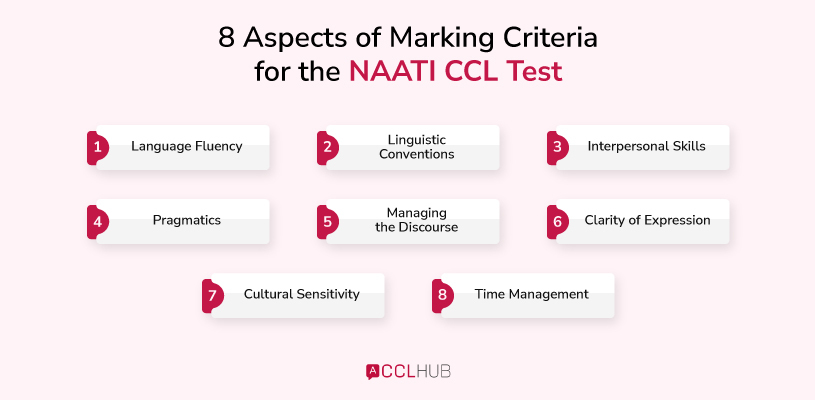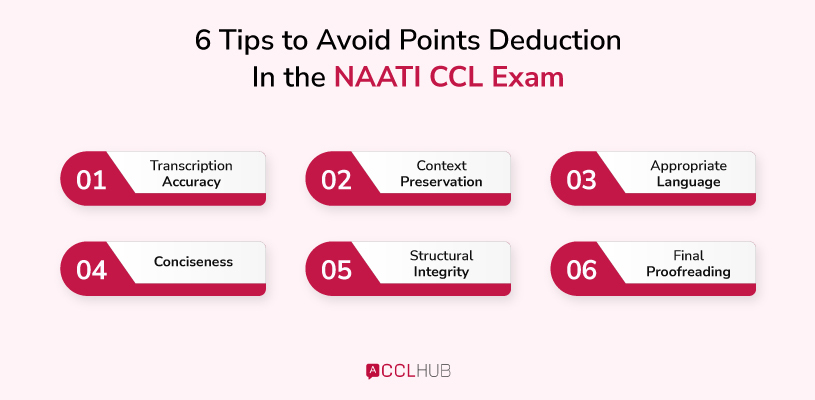
Marking Criteria for the NAATI CCL Test
Greetings to future Australia PR holders. I am writing this blog post to provide you with essential information about the marking criteria for the NAATI CCL test.
NAATI CCL Test candidates might still be in a dilemma about whether this exam is the right choice for them. However, with this blog, I aim to eradicate your confusion and help you with clear information about this test.
Also, you might be wondering, “Why is passing the NAATI CCL test so important?” Well, if you’re successful, you can earn five valuable points toward obtaining an Australian Permanent Residency. It’s like an extra boost to your immigration dreams.
Keeping that thought in mind, I will give you information on the marking criteria of the NAATI CCL Test. Also, I will provide you with heads-up about where you can lose your marks and what mistakes you can avoid for the NAATI CCL exam.
Let’s go.
💡Learn more: How to Access Free NAATI CCL Test Samples?
NAATI CCL Test: Marking Criteria Breakdown
For the NAATI CCL test, you simply listen to conversations in one language and write them in English or vice versa. Also, passing the test opens doors to career opportunities and Australian PR.
Now, let’s get into the details of how the NAATI CCL test is structured.
NAATI CCL Test Structure
The test has two dialogues, each with about 290 to 310 words. Two people talk in the dialogues, one in English and the other in another language (LOTE).
Each dialogue has six parts, which we call segments. Your job is to listen to and write the conversation in English accurately.
Moreover, there are six segments in English and six in LOTE, making a total of 12 segments in one dialogue, adding up to 24 segments. You have a limited time to complete both the Dialogue and Monologue tasks.
Hence, being quick and accurate in your translations and interpretation is vital.
Marking Criteria Breakdown
Now, let’s discuss how your performance is evaluated in the NAATI CCL test. I will unveil the scoring system essential to your success in this test.
First, you need to know that the test has full marks of 90. There are two dialogues, and each is worth 45 marks.
To pass the test, you need at least 29 marks in each dialogue and a total of 63 out of 90 overall. So, if you’re preparing for the NAATI CCL exam, aim for a minimum of 30 to 33 marks in each section to ensure you pass the exam.
Besides, the best tip I can give you from my experience is to keep your translations clear and consistent throughout.
8 Aspects of Marking Criteria for the NAATI CCL Test

Merely passing the test and moving on might not be your goal. You might want to pass it with a high score on your first attempt.
To achieve your desired score, you must know that the examiner considers various factors while marking you for the test.
In the following sections, we will break down these criteria into clear and accessible points to help you succeed in this test journey.
In this process, two of the aspects are highly analyzed. They are as follows:
1. Language Fluency
Language fluency means being really good at using the language you’re translating into. It’s not just about knowing the words; it’s about how smoothly you work with them.
Moreover, In the NAATI CCL Test, it’s essential to understand what’s being said in one language and express it in another without hiccups. Doing this will help you clear the NAATI CCL test on your first attempt.
2. Linguistic Conventions
Linguistic convention means following specific rules to score well in the test. In language, you need to follow the rules for grammar and vocabulary.
Also, In the NAATI CCL Test, you are assessed on how well you follow these rules when translating. You must be well aware of the rules to avoid mark deduction.
3. Interpersonal Skills
Interpersonal skills are like your ability to talk with different people in a friendly and appropriate way. It’s similar to being polite when speaking to someone.
Similarly, you need to maintain respect and professionalism when translating conversations.
It’s like knowing when to use formal and informal language. Besides, your ability to adapt to different situations while translating is crucial to passing the NAATI CCL test.
4. Pragmatics
Pragmatics is about understanding the hidden messages in conversations, like reading between the lines. It’s not just about the words themselves but also the intentions and emotions behind them.
It is similar to a sentence containing a subtext or deciphering a secret meaning within words. In the test, you must capture not just what’s said but also what’s implied.
5. Managing the Discourse
Moving on, managing the discourse is similar to organizing a series of events or ensuring all the story pieces fit together. Also, the NAATI CCL Test is about structuring your translation in a way that makes sense and flows well.
Hence, your translation should be clear and logical, and you must not allow the exam assessor to deduct your marks at any point.
6. Clarity of Expression
Clarity is a way of making things easy to understand, similar to having a clear road sign that guides you in the right direction. Not to mention, your translation should be straightforward and simple, with a precise message delivery.
Hence, your translations should be easy to read and understand to achieve the score you desire. Now, let’s discuss cultural sensitivity, a susceptible topic, while preparing for the NAATI CCL test.
7. Cultural Sensitivity
Cultural sensitivity involves respecting and understanding different cultures and traditions, like knowing when to take off your shoes when entering someone’s home because it’s their custom.
Similarly, In the NAATI CCL Test, you must show that you appreciate and respect the cultural aspects of the languages you work with. Doing this shows you recognize and respect different groups’ unique customs and beliefs.
Also, having a proper blend of cultural touch in your interpretation gives you a massive advantage in the eyes of your test assessor.
8. Time Management
Finally, we have time management in the NAATI CCL test. It is all about making the most of your available time.
Furthermore, you will have limited time to complete your translations. This means you must be efficient and make good use of your time to finish your tasks accurately and on time.
Also, this is similar to organizing your day-to-day schedules. You will have a specific timeframe to work in, and you must complete all your work within that timeframe.
You will not receive any extra time. Hence, you must practice mock tests frequently before appearing for the exam.
These detailed explanations should provide a more precise and comprehensive understanding of the NAATI CCL Test marking criteria.
🔔 Don’t Miss: Assessment Criteria of the NAATI CCL Exam
How to Avoid Points Deduction In the NAATI CCL Exam?

Following a specific set of guidelines is crucial to ensure you don’t lose points in the NAATI CCL Exam. These guidelines are your roadmap for success.
Hence, In this section, we’ll explore some NAATI CCL test facts, strategies, and tips to help you steer clear of point deductions and earn the marks you deserve.
Here are a few things you should keep in mind to avoid the deduction of your NAATI CCL points:
1. Transcription Accuracy
Transcription accuracy is a crucial aspect of the NAATI CCL Exam. In this context, transcription refers to the process of converting spoken words into written text.
When you’re tasked with translating a conversation in the exam, the words you write down must match what was said in the source language. Inaccurate transcriptions can result in point deductions.
Even a small transcription mistake can alter the message. However, one way to ensure transcription accuracy is by paying close attention to the original conversation.
Also, to further avoid transcription errors, you can practice your listening skills. The more you practice, the better your ability to accurately transcribe conversations.
2. Context Preservation
Context preservation is like keeping the background story of a conversation intact when you’re translating. It’s crucial to ensure that when you’re changing a conversation from one language to another, the context, or the bigger picture, remains clear.
Similarly, failing to preserve context in the NAATI CCL Exam can result in point deductions. It’s similar to telling a story but leaving out the important background information. Without the context, the story may not make sense.
To avoid this, you must consider the whole conversation, not just individual sentences. You need to see the bigger picture.
Furthermore, consider the emotions and intentions behind the words, ensuring the context is preserved, and your translation remains faithful to the original conversation.
3. Appropriate Language
Appropriate language means using the right style of language for the situation. Just as you wouldn’t wear casual clothes to a formal event, you must adjust your language to fit the context.
Also, using the wrong language style can lead to point deductions. For example, if you’re translating a formal business conversation, you should use formal language. On the other hand, if you’re translating a casual chat between friends, you should use informal language.
Furthermore, failing to match the language style to the context can make your translation feel out of place or inappropriate.
To avoid this, you should carefully assess the context of the conversation you’re translating. You should also think about the language most suitable for the conversation.
It’s important to remember that in the exam, you’re not just translating words; you’re also conveying the tone and style of the conversation.
4. Conciseness
Conciseness is like using the right amount of words to convey your message. In the NAATI CCL Exam, avoiding overly long and wordy translations is vital, as they can lead to point deductions.
For instance, you’re telling a story and want to ensure your listeners stay engaged. If you use too many unnecessary words and details, you might lose their interest. The same goes for the exam; overly lengthy translations can make the message less clear and less engaging for the reader.
However, if you wish to avoid this, aim for clarity in your translations. Also, concise language means getting to the point without unnecessary elaboration in the exam context.
You can prevent NAATI CCL point deductions and earn five Australian PR points by avoiding unnecessary details and staying focused on the core message.
5. Structural Integrity
Structural integrity is about maintaining the organization and order of your translations. In the NAATI CCL Exam, your translations should have a logical and organized structure.
Hence, to achieve structural integrity, consider the sequence of events in the conversation you’re translating. You need to organize your translation to reflect the original conversation accurately.
Moreover, you want your translations to be well-organized, with each part connecting smoothly to create a cohesive whole. Structural integrity ensures your translations are organized logically, following the original conversation’s flow, which helps you avoid point deductions in the NAATI CCL Exam.
6. Final Proofreading
Final proofreading is the last step before you submit your translations to the NAATI CCL Exam. It’s basically double-checking your work to catch any errors or mistakes. This step is crucial because failing to proofread can lead to point deductions.
Similarly, proofreading gives your translations a final check to ensure they are accurate and error-free.
Furthermore, carefully reviewing your translations to perform a successful final proofreading is essential. Besides, you want to ensure your translations convey the intended message clearly and effectively.
By dedicating time to this step, you can prevent point deductions and present translations that are of the highest quality. Avoiding point deductions in the NAATI CCL Exam and effectively showcasing your translation skills is crucial.
Earn 5 Australian PR Points With the NAATI CCL Test
Earning 5 Australian PR points through the NAATI CCL Test are more than just a numerical value; they are a testament to your skills, commitment, and vision of contributing to Australia’s rich and diverse society.
Also, they pave the way for a promising future in Australia where you can thrive and make a lasting impact.
The road to permanent residency in Australia can be challenging and highly competitive. Every point can make a significant difference in the success of your application.
Likewise, the 5 PR points offered through the NAATI CCL Test are part of the General Skilled Migration (GSM) program, which assesses applicants based on their skills, qualifications, and other factors.
✅Also, check out: Benefits of one-on-one online classes for NAATI CCL
Role of NAATI CCL Test
The NAATI CCL Test is vital in acquiring these 5 PR points. It is a specialized language proficiency assessment primarily focused on evaluating your translation skills in languages in high demand in Australia.
However, successfully passing this test demonstrates your ability to accurately and effectively translate conversations between English and your chosen language pair. The test proves you possess the linguistic aptitude necessary to contribute to Australian society’s diversity and demands.
Also, gaining permanent residency in Australia is a significant achievement and a life-changing event. It offers you the privilege of living and working in Australia with minimal restrictions.
Hence, the 5 PR points offered by the NAATI CCL Test are your key to unlocking a smoother pathway to this coveted status. These points make your application more competitive and are often the difference between being selected and overlooked.
Increased Employability and Community Integration
Your language skills can set you apart in Australia’s competitive job market. Passing the NAATI CCL online Test can enhance your employability.
Additionally, employers appreciate individuals who can bridge language gaps, especially in industries requiring clear and effective communication. Your NAATI CCL certification can demonstrate your linguistic skills and your potential value in the Australian workforce.
Moreover, effective language skills are not only vital in the professional realm but also in daily life. These skills facilitate your ability to engage with locals, understand cultural nuances, and participate actively in Australian society.
The 5 PR points you earn through the NAATI CCL Test reflect your potential to integrate into the Australian community and contribute positively.
Positive results in this test can work wonders. However, I only recommended to book the NAATI CCL test after developing a good amount of confidence.
CCLHUB for NAATI CCL
CCLHUB is a central hub that offers a wealth of tools, materials, and guidance designed to assist test-takers on their journey to NAATI CCL success. It’s like a one-stop destination where you can find everything you need for efficient and effective test preparation.
Some important resources CCLHUB provides to help you clear the NAATI CCL exam in under one week are:
1. Mock Tests
CCLHUB often offers a variety of NAATI CCL mock tests that closely mimic the format and difficulty level of the actual NAATI CCL Test.
Similarly, these practice tests allow you to familiarize yourself with the test structure, hone your translation skills, and build confidence.
2. Study Materials
Moroever, CCLHUB provides NAATI CCL preparation materials that cover essential linguistic and translation concepts. These materials are tailored to the specific languages covered in the NAATI CCL Test and are designed to improve your language proficiency.
3. Tips and Strategies
CCLHUB often offers valuable insights, strategies, and tips on effectively approaching the test. This guidance can help you navigate the nuances of the NAATI CCL Test and maximize your performance.
Also, our CCL experts are always available to help and assist you at your convenience.
4. Free Test Samples and Vocabulary
Lastly, CCLHUB provides free test samples and vocabulary that enable you to assess your readiness for the NAATI CCL Test. These resources are valuable for knowing your current proficiency and identifying areas requiring further improvement.
Hence, by using CCLHUB as a part of your test preparation strategy, you can efficiently enhance your language proficiency and translation abilities, which are central to success in the NAATI CCL Test, and earn that five Australian PR points.
Conclusion
In conclusion, understanding and effectively applying the Marking Criteria for the NAATI CCL Test is essential for success in this language proficiency examination. These criteria act as the foundation for accurate and precise translations and serve as a roadmap for achieving the desired results in the test.
By following these criteria, you increase your chances of passing the NAATI CCL Test and open doors to promising career opportunities in the linguistic field and the potential to earn valuable Australian PR points.
Also, remember that the NAATI CCL Test is not just an examination but a gateway to a world of linguistic opportunities and to make your journey towards Australian permanent residency more attainable.
FAQ
Q.1: What are the Marking Criteria for the NAATI CCL Test?
The Marking Criteria for the NAATI CCL Test are the guidelines and standards examiners use to assess your translations. They cover various aspects, including accuracy, linguistic conventions, context preservation, language appropriateness, structure, and more.
Q.2: How important is learning about the Marking Criteria for the NAATI CCL Test?
The Marking Criteria are of utmost importance. They determine whether your translations meet the required clarity, accuracy, and effectiveness standards. Comprehending and applying these criteria can significantly impact your test results.
Q.3: How can I meet the Marking Criteria in the NAATI CCL Test?
To meet the Marking Criteria, practice is key. Work on your language proficiency, pay attention to the details in conversations and focus on preserving context, adhering to linguistic conventions, and ensuring structural integrity in your translations. Also, regular practice tests and self-assessments can help you align with these criteria.
Q.4: What’s the significance of context preservation in the Marking Criteria?
Context preservation is crucial to ensure that a conversation’s broader meaning and background remain intact during translation. Failing to preserve context can result in point deductions, as it may lead to misunderstandings or incomplete translations.
Q.5: How can I maintain structural integrity in my translations for the NAATI CCL Test?
To maintain structural integrity, logically organize your translations, ensuring they follow the flow of the conversation. Use paragraph breaks, punctuation, and sentence structure to mirror the original dialogue. This helps readers follow the conversation seamlessly.
Q.6: What’s the advantage of adhering to the Marking Criteria for the NAATI CCL Test?
Adhering to the Marking Criteria ensures that your translations meet the required standards and opens up opportunities for a career in the linguistic field. Additionally, passing the test can earn five valuable Australian PR points, making your path to permanent residency in Australia more easy.



